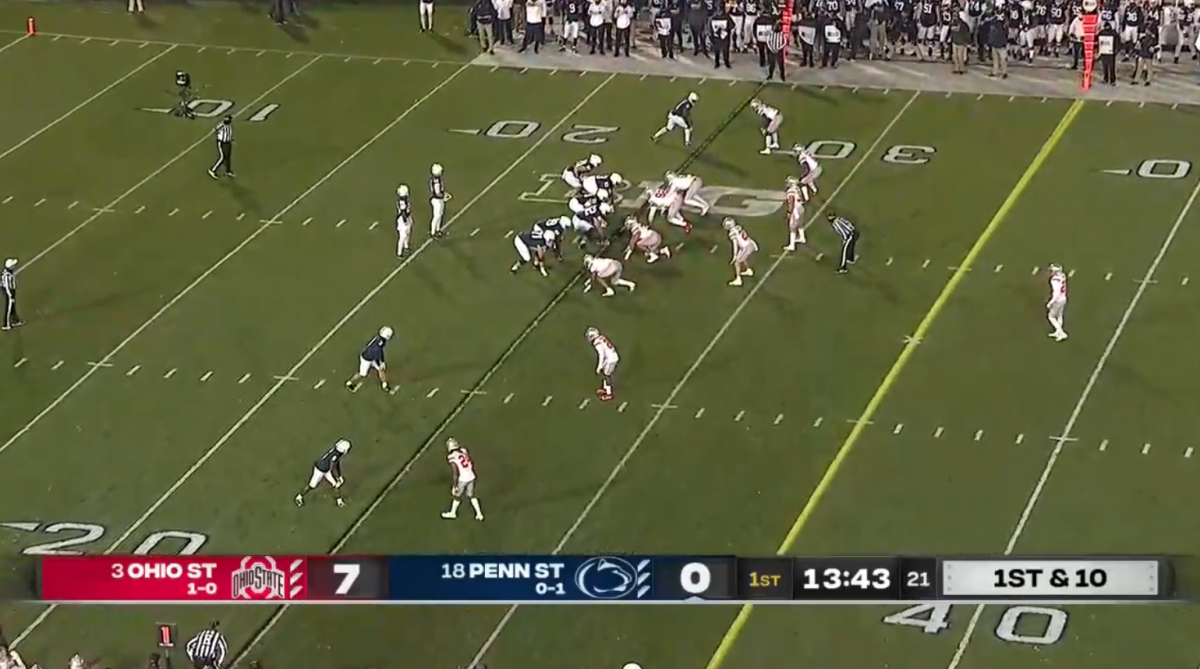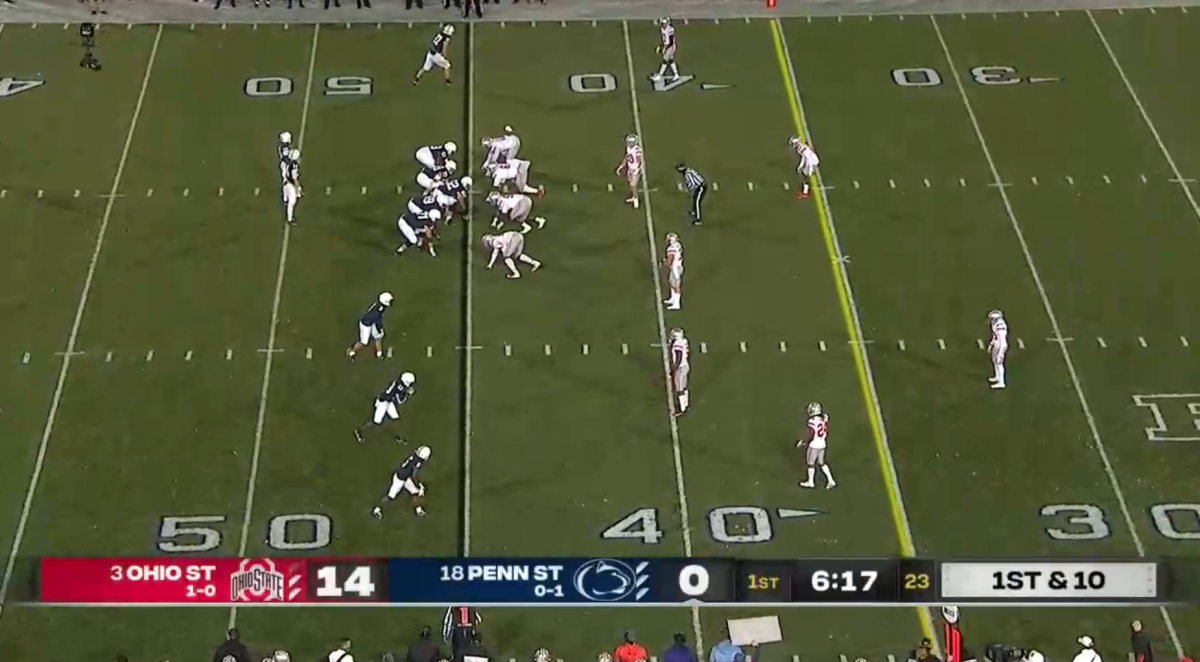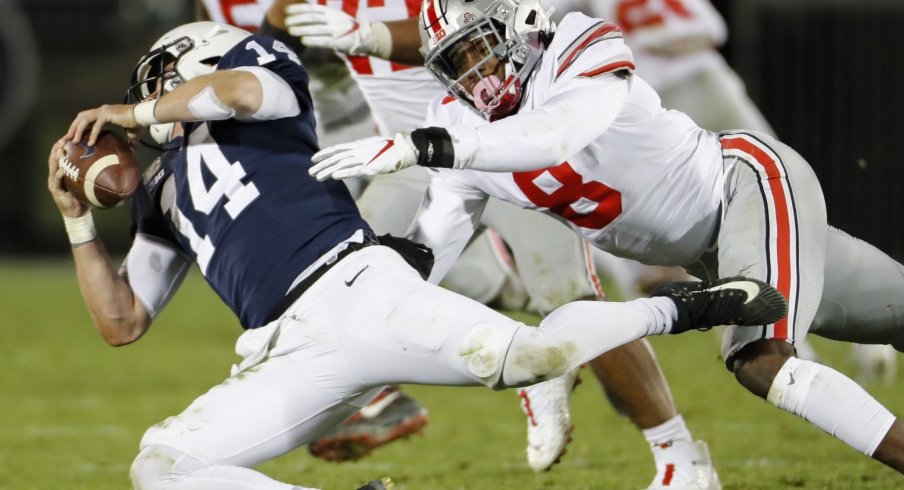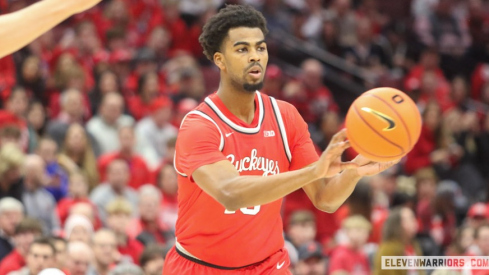Today's show is brought to you by the numbers...
1.6 - That's how many yards Penn State gained on average whenever they ran the ball last Saturday night against Ohio State
4 - The number of first downs the Nittany Lions picked up on the ground during that game
7 - Ohio State's tackles-for-loss in the contest
119 - PSU quarterback Sean Clifford's rushing yards the week prior against Indiana
"For us, offensively, we really struggled in the first half, not being able to run the ball pretty much the entire game, and not being able to protect Sean [Clifford]. He was getting hit way too much and had people in his face way too much," James Franklin said after the game.
It's hard to disagree with Penn State's head coach on this topic, as his offense never got going in the first half against its arch-rival. By the time they set foot on the field, Clifford and co. were already behind, as former Nittany Lion pledge Justin Fields led the Buckeyes down the field for a quick score and set the tone for the rest of the evening.
Ever since Franklin revived his program with the hiring of Joe Moorhead to design an option-oriented system around stud tailback Saquon Barkley in 2016, the PSU offense has been one of the more dynamic units in the Big Ten. It's produced stars like Barkley and Miles Sanders in the backfield, wideouts like K.J. Hamler and DaeSean Hamilton, and tights ends Mike Gesicki and the current Y, Pat Freiermuth.
By hiring play-caller Kirk Ciarrocca away from P.J. Fleck's staff in Minnesota last winter, Franklin reinvigorated the attack by adding new pieces to the RPO-pie. The Gophers ranked fourth in the conference in total offense last season, and Ciarrocca was expected to bring new life to a unit that had lost its edge against top opponents following Moorhead's departure in 2018.
After the first snap against Ohio State, however, it became clear that a monumental task stood before the PSU offense. Though the visitors from Columbus didn't feature multiple preseason All-Americans as they had in years past, the Buckeye front seven still showed its ferocity.
Ciarrocca called a simple BASH (Back-Away Sweep) concept on the opening play, and Clifford appeared to have a hole up the middle after pulling the ball away from the tailback. Yet although he'd given Clifford a "keep" read with his movements just a moment before, senior end Jonathon Cooper lunged at the accelerating QB to snuff the play out for just a short gain.
Cooper, of course, played one of the best games of his career that evening, winning battles with the Penn State tackles all night, registering five tackles and a sack. But he wasn't alone.
Playing their hearts out for their mentor and former PSU assistant, Larry Johnson Sr., the entire OSU defensive line stood out all night. Nose tackle Tommy Togiai was named Big Ten defensive player of the week after he led the team in tackles with seven, including three sacks, while ends Zach Harrison and Javontae Jean-Baptiste joined the party with sacks as well.
Behind them, however, lay a less-heralded, yet equally important component of the unit.
Pete Werner emerged as a crucial piece of the Buckeye defense last fall and continues to play well in a new role as the WILL linebacker in his final season in the Scarlet and Gray. Meanwhile, fellow senior Baron Browning appears more comfortable than ever at the SAM spot, using his size and athleticism to make plays against tight ends like Freiermuth in addition to rushing the passer on third downs.
On this night in Happy Valley, however, the Buckeyes beleaguered middle linebacker seemed to be everywhere. Fans have never seemed to forgive Tuf Borland for being out of position in the loss to Iowa in 2017, yet now, in his second year as a captain and fourth as a starter, he is the foundation of the Ohio State run defense.
Throughout the evening, Borland seemed to make unheralded plays like the one below:
As the right tackle (#71) chips the optioned defender, DE Tyler Friday (#54), Borland immediately recognizes the play, darting around the tackle's block and stuffing it for no gain. The MIKE 'backer had done his homework beforehand to know what to expect, took no false steps to meet the runner in the hole, and laid the wood when he arrived.
Last I checked, these are the same traits Ohio State fans have longed for in a middle linebacker, and it's time for Borland to get his due.
But Borland wasn't just a factor against inside run plays. The Nittany Lions attempted to beat the aggressive Buckeye pass rush with numerous RB screens throughout the evening, yet Borland sniffed them out each time, forcing Clifford to improvise with little success.
While Werner, Harrison, and Cooper got plenty of camera-time below, they're only in the picture because Borland immediately recognized the back leaking out for a screen, alerting Browning to help and leaving the QB with nowhere to go.
In his fourth tilt against the Penn State option attack, Borland surely recalled former PSU signal-caller Trace McSorley taking off on draw plays with great success. Yet this time around, he clearly had no interest in allowing that trend to come back in style.
After looking downfield for a quick pass that wasn't there, Clifford tucked to run behind his blocking tailback and the releasing interior line. But the center (#62) was never able to lay a clean block on Borland, who slipped by and made one of his five credited tackles on the evening.
"We felt like going into the game, the quarterback running game would be something that would be a big part of the game," Franklin told the media Saturday night. "We weren't able to get that going either."
Thanks to efforts like these, the Nittany Lions able to only muster 75 yards of offense in the first half, and trailed 21-6 at the break. But the credit doesn't just go to the players, as they were given a fantastic game plan to defend Penn State's trademark Run-Pass Options.
Throughout the first half, the home team saw results like the below, where the Buckeyes seemed to know what was coming before the ball was even snapped. It's unclear whether it was due to the formation, personnel, down and distance - or a combination of all three - but the OSU staff clearly recognized Penn State's tendencies, allowing them to shut down complex RPOs like the one below:
One reason the Buckeyes seemed so dominant early was a subtle adjustment in the way they lined up. While they often started in the same, single-high safety alignment Jeff Hafley implemented a year ago:

...the Silver Bullets began lining up with both Marcus Hooker (#23) and Marcus Williamson (#21) splitting the field at the safety spots throughout the game last weekend:

From this look, the OSU defense played zone-match Quarters coverage, much like the one seen from Mark Dantonio's Michigan State teams. Not only did this change the way the Buckeyes defended the pass, but how they fit the run as well.
One of the advantages of the single-high structure is the ease with which the D-line and linebackers can fill each run gap, but its predictability can be a liability against QB runs. In Quarters, the backside safety (often Williamson) becomes a run defender, filling a backside gap and complementing the defensive end who is often read on option plays.
As we saw on the Nittany Lions' longest run of the night, a 23-yarder from Devyn Ford in the first quarter, Williamson had his eyes in the backfield and watched as Tyreke Smith (#11) took the QB on a simple zone-read play. But the slot corner-turned-safety took a false step backward and was caught flat-footed as Ford ran right past him.
Clearly, the Buckeye defense hasn't practiced defending the run from this structure as they have in single-high setups. Yet when put in a nearly identical situation later in the game, Williamson got down in the box much quicker, forcing Clifford (who kept this ball this time) out of bounds for a minimal gain.
Despite all this success, however, Penn State marched right down the field on the opening drive of the second half and found the end zone, suddenly making it a one-score game. The Nittany Lions had found some success on a handful of early RPOs by getting the Buckeye linebackers flowing in one direction to stop the run, then throwing a quick slant or tight end drag through the open window they'd left behind.
"I think we had a couple of schemes that worked in the first half. And we went back to them, things that were giving them problems," Franklin noted of the early second-half success. "We were able to get some momentum, we were able to get the ball out of Sean's [Clifford] hand, whether it was on the perimeter to Jahan [Dotson], or whether it was Pat [Freiermuth] on a misdirection pass."
Dotson, of course, would go on to have a huge second half, hauling in seven catches for 124 yards and three touchdowns in the final two periods alone. When given the freedom to release cleanly at the line, he gave the Buckeye secondary all kinds of trouble, including a pair of highlight-reel one-handed grabs over Shaun Wade.
But the bread-and-butter of the Penn State attack was the backside slant in an RPO. Dotson scored twice on such plays, but eventually, the Buckeyes were able to punch back, adjusting their man-free (Cover 1) coverage to take away the open window.
While Cooper and Jean-Baptiste do an excellent job of collapsing the pocket, the adjustment of not only pressing Dotson at the line, but allowing Browning to play as a "robber" or "rat" underneath, meant the Buckeyes could defend the run with Werner and Borland while also taking away the slant.
Adjust the coverage was a major storyline for the Buckeye secondary in this game, as they not only showed Quarters coverage but a number of others from their two-high looks. On third-and-long, the Buckeyes sometimes showed a new wrinkle, known as Cover 5 to some, and Cover 2-Man to others.
The concept is simple, as the five eligible receivers are all taken in man-coverage while the two safeties each play a deep-half zone. This allows the underneath defenders to play very aggressively in coverage as they know there is help over the top.
It's a great concept to run when the offense has a long way to go, as the only real weakness is the QB taking off on a scramble for short yardage underneath.
Another wrinkle seen more often was the use of simulated pressures. Ohio State's 3-3-5 nickel package with Browning, Werner, and Teradja Mitchell manning the linebacker spots behind three down linemen appears to be the most effective way to get to the quarterback.
From this look, they'll often send one of the linebackers on a pass rush, with Browing usually drawing this assignment. However, as the game progressed, coordinators Kerry Coombs and Greg Mattison began sending Werner through the A-gap while dropping Browning and Mitchell as the unit played Cover 3 Buzz with safety Josh Proctor filling a Hook zone in Werner's place.
The combination of rolling from a two-deep alignment to a single-high coverage along with the uncertainty of who would act as the extra rusher seemed too much for Clifford to process at one time, leaving the home team with just three third-down conversions on nine attempts.
Outside of Dotson's heroic 144-yard performance, the Penn State offense accounted for just 181 yards of total offense, including a meager 44 yards rushing on 27 attempts. Clifford, in particular, seemed to struggle as the Buckeyes shut down the QB run game entirely, allowing him just five yards rushing on 18 carries.
There is still plenty of work to be done, as the Buckeyes must find more answers in the secondary. Mixing in more two-deep coverages as they did in Happy Valley will help keep offenses off-balance, but only if the players are capable of executing them without hesitation.
But on a night where Justin Fields shined in the national spotlight, many of his lesser-known teammates on the other side of the ball did their part to earn the biggest win over Penn State in a half-decade.
"Obviously, not being able to have a running game, with a D-line like that, that can just tee off on you in the passing game, you've got to be able to be balanced," Franklin said of the Buckeyes. "It just makes it too challenging on the offensive line and on the quarterback."



